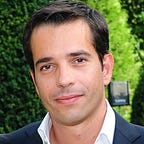How Nestlé USA is innovating like a startup
Five key ways we’re unleashing Nestlé’s 150 year old innovation heritage
When I asked my four-year-old daughter what she wanted to eat the other day, I expected a typical response: “French fries”. But her actual answer — “sushi” — is a perfect example of how quickly the world of food is changing.
Food and beverage companies like Nestlé have to adapt to the new culinary demands of consumers. Consumers today have diverse and quickly evolving needs and desires, and we either meet them where they are or watch them walk away.
To keep up with consumers and to serve them well, we must live, work, and breathe innovation. And while many companies talk about innovating, few actually do. More than 150 years ago, Henri Nestlé launched a ‘start-up’ to save a neighbor’s undernourished child. The next 150 years brought continuous innovation and transformation, making Nestlé arguably the most successful startup ever.
And though Nestlé has been able to thrive for a century and a half because of our innovation, we’ve never before seen the kinds of dramatic shifts in the market — from consumer habits, behavior, and engagement with brands to how goods are purchased — that we’ve witnessed in the past 10 to 15 years. Take your local grocery store, for example. Roughly a decade or so ago, a shopper would have had a few thousand items from which to choose. Today, that same store will have about 40,000 items. If you shop at a Wal-Mart supercenter, it’s as high as 150,000. Peruse Amazon, and you’ll find millions of products that can be delivered to your doorstep.
In addition to these overwhelming consumer choices, small brands are challenging big brands in trust and credibility. People’s palates are changing, too, as routine consumption of food has given way to culinary discovery, where we as consumers have control over our food’s nutrition, flavor, sourcing, and sustainability. Consumers are more informed and sophisticated than ever. And for businesses eager to serve this changing marketplace, startups can launch with little more than an idea and a laptop.
For Nestlé, this consumer revolution means that we either wait for someone to disrupt us, or we disrupt ourselves. Spoiler alert: We’re choosing the latter. But controlled disruption must be strategic, not erratic. At Nestlé, we’re taking a multipronged approach to strengthen our base brands and build new horizons. We are coupling our broad capabilities, know-how and scale with a startup’s speed and mindset to everything we do — and that begins with innovation.
Winning in today’s environment requires an hybrid growth model, which means companies must drive value from their base business portfolio while also embarking on new ventures that seed future growth. Here’s how we’re making it happen at Nestlé:
Innovate with our base brands
By capitalizing on key consumer trends, Nestlé is able to cultivate new products to reinvigorate our beloved classic brands and make them more modern and relevant for the next generations. Coffee-mate Natural Bliss entered plant-based dairy alternatives, with four new offerings: Vanilla Almond Milk, Caramel Almond Milk, Hazelnut Almond Milk and Sweet Crème Coconut Milk. From Stouffer’s organics to Häagen-Dazs Non-Dairy, we’re finding inspiration in our tried-and-true brands.
Launch internal incubators
Nestlé has a launched “internal startups” in which “intrapreneurs” can rapidly develop new product lines with lean designs, fast prototyping, and quick in-market testing. Agile and quick now coexists with more traditional approaches to innovation. What once was a multiyear process can now happen in just a few months. Also acting to satisfy consumer desires, the narrative and packaging of these products — as well as digital-first marketing — serve as differentiators. This innovation model allows us to go places we have not been able to go before and has launched new innovative products and brands to meet the evolving needs of our consumers.
Leverage external partnerships
We’re also seeding innovation externally to create real change by leveraging the broad innovation ecosystem. Nestlé is partnering with Rabobank and RocketSpace, a well-known Silicon Valley incubator, to support startups in the Terra Food + Ag Tech Accelerator program. This first-of-its-kind initiative was established in 2017 to fuel cross-industry innovation and to set new standards for food and agriculture. More than 200 startups applied to the program, 18 were selected to work on pilots together with progressive corporations such as Nestlé.
Make complementary acquisitions and investments
The companies we have recently invested in or acquired feel like they’re from the same family, and that’s by design. Sweet Earth (plant-based foods), Blue Bottle Coffee (high-end coffee), Chameleon (premium organic cold brew coffee) and Freshly (direct-to-consumer healthy, fresh meals) already have strong products, a culture of innovation, and a deep understanding of these growing markets. Each complements our approach to innovation and belongs on our roadmap for growth. In fact, when we combine the creativity born from the startup culture with the resources of Nestlé, we can create real change in our industry and best deliver on consumer needs.
Build new growth-enabling capabilities
Finally, though I’ve laid out the many ways we’re innovating in our portfolio, Nestlé is also innovating in operations, from how we recruit talent to how we use data analytics to drive strategies and optimize our supply chain to how we deploy flexible manufacturing solutions. Innovation was once the terrain of marketers and R&D teams. Today, innovation is everyone’s job, and that empowers our entire workforce to find new ways to serve our consumers and customers.
Nestlé USA Chairman & CEO Paul Grimwood has said: “Innovation is our lifeblood.” Our 51,000 employees in the USA are our pulse. They’re the enablers of our present and future as an innovation powerhouse.
